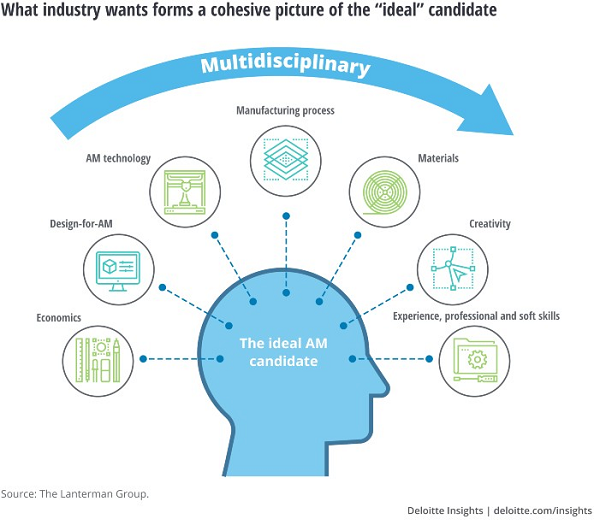- FMA
- The Fabricator
- FABTECH
- Canadian Metalworking
Our Publications
Categories
- Additive Manufacturing
- Aluminum Welding
- Arc Welding
- Assembly and Joining
- Automation and Robotics
- Bending and Forming
- Consumables
- Cutting and Weld Prep
- Electric Vehicles
- En Español
- Finishing
- Hydroforming
- Laser Cutting
- Laser Welding
- Machining
- Manufacturing Software
- Materials Handling
- Metals/Materials
- Oxyfuel Cutting
- Plasma Cutting
- Power Tools
- Punching and Other Holemaking
- Roll Forming
- Safety
- Sawing
- Shearing
- Shop Management
- Testing and Measuring
- Tube and Pipe Fabrication
- Tube and Pipe Production
- Waterjet Cutting
Industry Directory
Webcasts
Podcasts
FAB 40
Advertise
Subscribe
Account Login
Search
Preparing the next generation of additive manufacturing professionals
Unless manufacturers can effectively scale this new technology into production uses, the real promise of 3D printing may not be fulfilled
- April 5, 2019
Excerpted from a research report titled “3D opportunity for higher education,” published by Deloitte Insights.
Additive manufacturing (AM) is revolutionizing the way many products are designed and manufactured. However, unless manufacturers can effectively scale this new technology into production uses, the real promise of AM may not be fulfilled.
One of the challenges often identified as limiting AM’s scale is the lack of a capable and skilled workforce. With that in mind, industry leaders continue to seek workers possessing broader knowledge across both the design and manufacturing disciplines to help innovate and optimize new products for the efficient use of AM technologies.
Toward that end, the industry leaders and academicians interviewed for this report agreed that a new mindset might be required to unleash the full potential AM offers as a suitable production alternative. Below are five key workforce education “needs” mentioned by the interviewees:
1. A multidisciplinary understanding of key AM-related knowledge areas, such as material science, design, and engineering.
2. Better design knowledge, specifically as it relates to DFAM (design for additive manufacturing).
3. A broader, more creative, and innovative mindset.
4. A better understanding of AM’s ties to existing manufacturing processes, not just AM.
5. A commercial mindset, one able to understand the AM business.
Putting these five needs together reveals a picture of the “ideal” candidate: He or she is a multidisciplinary learner with strong roots in design and creativity and is grounded in manufacturing process fundamentals.
The ideal candidate would likely require an understanding of engineering design and application using AM technologies, in addition to knowing the manufacturing process fundamentals of machinery, materials, and resources—all within the strategic business context. To produce AM innovations, a broader, more holistic way of thinking is required for product and process design, manufacturing process design, and business models.
These five needs do not form the entire story in the evolution of AM education, of course, in at least a couple of ways. First, industry needs are more nuanced than what we generalize here. In that way, they are largely informed by individual circumstances. Second, industry is just one constituent in this discussion. Students, too, care deeply about the quality of the AM education they receive.
Toward that end, two key perceptions came to light during our research. First, students now expect their academic institutions to have highly accessible, open-access machines and higher-grade facilities than the small, consumer-type desktop printers they used in high school. Second, students want robust and ongoing career guidance and mentoring relationships with industry professionals as they embark on their AM-related careers.
Student expectations of what an AM education means are rising, and academic institutions should adapt to meet those expectations.
Deloitte Insight contact: Mark Cotteleer, mcotteleer@deloitte.com.
About the Publication
- Podcasting
- Podcast:
- The Fabricator Podcast
- Published:
- 04/16/2024
- Running Time:
- 63:29
In this episode of The Fabricator Podcast, Caleb Chamberlain, co-founder and CEO of OSH Cut, discusses his company’s...
- Trending Articles
- Industry Events
16th Annual Safety Conference
- April 30 - May 1, 2024
- Elgin,
Pipe and Tube Conference
- May 21 - 22, 2024
- Omaha, NE
World-Class Roll Forming Workshop
- June 5 - 6, 2024
- Louisville, KY
Advanced Laser Application Workshop
- June 25 - 27, 2024
- Novi, MI




























